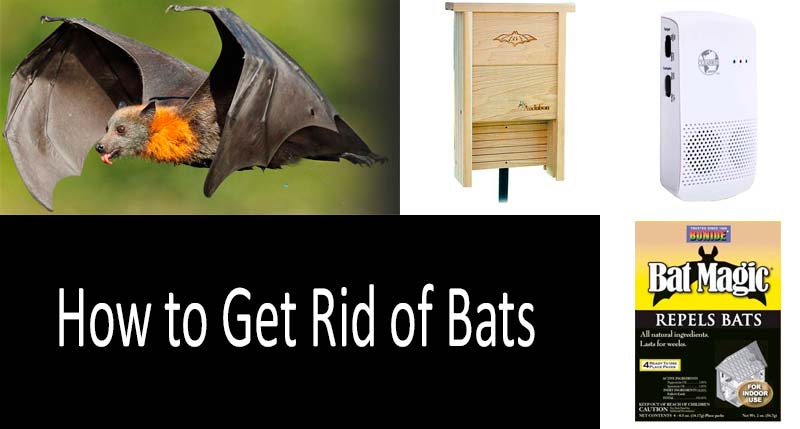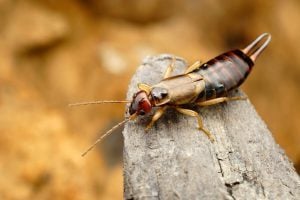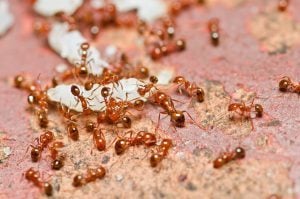What is the best way to get rid of bats? You have two options: repelling bats from your house and mounting an alternative house for them in the yard. The former is a short-term solution while the latter will allow you to solve your bat problem for a long time.
The bat repellents can be of two types: odor repellents and electrical deterrent devices. Odor repellents are based either on toxic chemicals, like the Enoz Original Moth Balls, or natural active ingredients with a strong smell, like the Bonide Bat Repellent made with essential oils.
Electronic deterrents repel bats with light, sound, or airflow and are more efficient against bats. For example, the Cleanrth Pest Repelling System uses electromagnetic waves and is a very powerful repeller.
Nevertheless, the most effective solution in combination, is to build a new roosting site for bats or purchase a ready-to-use one, such as the Audubon Bat Shelter.
|
Enoz Original Moth Balls, 4 oz Each, 4 Pack |  Check the current price |
|
Bonide (BND876) – Bat Magic Ready to Use Indoor Bat Repellent |  Check the current price |
|
Cleanrth CIN009 Industrial Electronic Pest Repelling System |  |
|
Audubon Bat Shelter Model NABAT |  |
Having bat infestation in the attic sounds terrible to many homeowners. Upon hearing these words, particularly when it comes to a large colony established by these animals, one would wish just to give up everything and start looking for a new home. The reason for that is that numerous myths have grown up around bats, making people fear these flying creatures, instead of learning how to get rid of bats properly.
The biggest myth about bats is that they are vampires feeding on human blood. In most cases it is not true. Yes, there is a particular sub-species, which specifically prefers blood (what is meant here is animal blood, not human blood). This species is dangerous and can carry diseases, but you’ll have to try hard to encounter them and should attack them first to get bitten for sure. The vast majority of bats that inhabit human accommodations feed on insects (mosquitoes, flies, etc.), or, less frequently, on small animals such as frogs. Therefore, these pests are not exactly pests. They can be “tamed” and you can build special bat shelters for them (refer to our separate article covering the best bat houses). But still, there are species that feed on fruit causing damage to horticulture. It would therefore be preferable to keep these creatures away. These are covered in the following review.
Taking measures to repel bats at the wrong time of year, in spring, you might well find your area being a shelter for midges, mosquitoes and various beetles. It’s an unpleasant surprise, isn’t it? To avoid this, we have prepared for you this guide to getting rid of bats in the right way. In the beginning, we will tell you about their habits and life, the ways how to smoke them out of an attic, and will teach you what to do when a bat flies into a house. Then we’ll find out which repellents work against them, and which don’t.
- What You Should Know Before Getting Rid Of Bats
- How to Get Rid of Bats in the Attic
- Which Bat Repellent is the Best?
- What Should You Do If You Find a Bat in Your House?
Bat Facts Which You Have To Know Before Getting Rid Of Bats
First of all, make sure that it’s bats you are dealing with. As John Simpkins, a co-owner of Edgewood’s Mid-Atlantic Wildlife Control, put it in an interview with The Washington Post, “Ninety-nine percent of people who say they have bats in chimneys have chimney swifts.” According to him, the best way to clarify the issue is to look at the creatures’ behaviour at dusk. Bats fly out in search of food at that time, whereas chimney swifts roost. In the case of the latter, no measures are needed to be taken since chimney swifts are on their way to South America to make it through the winter, and will not stay in the area for more than a month.
If it’s bats, there is still no reason to panic since these animals are rarely aggressive unless they are being chased. However, a chilling rustle of their wings is likely to disturb the night rest of residents of the house, as well as odors from large bat colonies might cause nuisance. Besides this, when in contact with bats without wearing gloves, a person risks being bitten and potentially exposed to infection. Indeed, in this regard, you should move on to action and here’s what you need to know:
- Bats don’t build nests, that’s why they settle in areas already inhabited by humans, such as attics, chimneys, towers, barns, and they often fly into the living rooms of houses, settle in ventilation and balconies. They can also settle in abandoned buildings and under the bridges.
- Bat breeding is usually delayed, as after conception in winter the offspring will emerge only in May and June. End of the summer is the most critical time as that’s when the young begin to fly, so you may find the bats population sharply doubled.
- The colonies consist almost entirely of females. Every year, they give birth to about one pup, but some may have 2-3 of them.
- Bats, like their distant non-flying cousins mice, are very agile and nimble: a slit ⅜ of an inch in size would be enough for them get into the house.
- Bats sleep during the day, and at night they fly away in search of food and water. They can endure several flights during the night. They use echolocation to navigate around, but they are not entirely blind, contrary to the widespread stereotype.
- Most bats are unlikely to live in the same structure throughout a year, however, they get accustomed to their roosts and may come back the next season.
- Bats can transmit dangerous diseases through a bite, such as rabies, dangerous Marburg and Ebola viruses. Fleas, ticks and other parasites can live on bats, but they are particular as they are well bound with the host and are not dangerous to humans. According to the University of California Agriculture and Natural Resources scientists, “No evidence exists of disease transmission to humans or domestic pets from bat parasites. Parasites that remain after bats have been removed from buildings soon die without their hosts”. For more information about danger of bats, and what diseases they carry, refer to the very end of our guide.
- In many countries bats are protected by law and cannot be shot or poisoned.
Why Are Bats Useful? The main use of bats is that they can eat up to 600 mosquitoes per day, which is confirmed by the University of Kentucky scientists.
Insect slaughter is not the only benefit of bats. The same Kentuckian scientists have discovered that bats are engaged in pollination and seed dispersal of wild fruit, such as bananas, agave, peaches, figs and many others. They thus contribute to the preservation of the ancient plant species and to the birth of new ones. Theoretically, bats may help your future and garden crops.
How to Get Rid of Bats in Attic
Over 45 types of bats exist in the USA, and all of them are insectivores (with few exceptions). Each state has its own bat species, and many of them prefer living out in the wild and in the caves. If you have a bat colony at home, it is most likely the Little Brown Bat or Big Brown Bat in the North and Mexican free-tail bat, and Evening bat in the South.
This classification is conditional, but you do need to know the type of bats inhabiting your attic in order to get rid of them. What is important is:
- The methods which can be used against bats
- When they can and cannot be used
As a rule, the bats settle in attics closer to the summertime, when the females which represent the majority of the colony, prepare to give birth. Of course, these intruders may just fancy your home in the winter, but it’s more common to find the signs of bat infestation, such as night rustle, fur debris and feces on the roof, as well as a sharp decrease in the amount of harmful insects in the yard, in April and May.
With summer round the corner, it’s time to face the fact that you share the house with these creatures. On the positive side, having bats in the attic, you will find yourself enjoying the absence of mosquitoes. But still, the first thing that will spring to your mind will probably be: “How to get rid of these creatures? What if they bite me? How am I supposed to live in this house?” Sooner or later the autumn will come, and that’s when it will be possible to take a vital action.
David F. Tessler, Regional Wildlife Biologist, Nongame Program, Alaska Department of Fish and Game Division of Wildlife Conservation, claims that both moth balls with naphthalene as an active ingredient and ultrasonic pest repeller are ineffective in repelling bats. In particular, naphthalene should be applied in huge amount to be effective, what can harm a human health. Nor does trapping work as it turns out to be a waste of time since bats accustomed to that place are likely to be back. Pesticides and poisons are forbidden by the law. In view of the above, Mr. Tessler names exclusion as the only method to get rid of bats that really works. To exclude bats, you may either address to professionals or do it yourself.
6 Steps to Get Rid of Bats
Below you will find the steps required to be taken to exclude bats:
- Find the loopholes that bats use to get into your home, be it the flow-through ventilation in the attic, the chimney, open windows, the hole at the junction of walls and roof, or the gaps in the walls and siding. They can use all of this. As mentioned above, a narrow slit will be enough for them to slither inside and dwell within. Take into account that as soon as bats return, they will try hard to find another way into the house, therefore any small opening along a roof-line or any other parts of the building located near the old entrance inside should be thoroughly examined.
- Wait until the nightfall for these terrible creatures to fly away in search of food. But first make sure that there are no bats left in the building, since some of them may remain inside all night. Therefore, never seal openings right after having the bats flown outside.
- For that purpose, use exclusion devices such as plastic pipes or netting serving as one-way valves and are meant to be placed over all openings through which these creatures get in and out of the house.
- Tubes should have a diameter of two inches and be about 10 inches in length. Use either manufactured tubes available on the market or make them yourself from PVC pipe. The device should project a one-quarter inch into the opening, so that remaining bats could easily get into the tube. Once the tube has been installed, seal openings outside of tube with caulk.
- Plastic netting is placed over openings on exterior walls and should be secured along the top and sides of the hole, while the bottom of the netting should hang loose. This will allow remaining bats to easily get out of the shelter, while those outside will have no chance to get in.
- Wait for a week to make sure that not a single bat is left inside, and you are free to permanently seal all the entrances and exits.
Moderately priced sealants and versatile flexible metal nets are available on the market. Among them, there are Reflective Bird Repellent Scare Tape – 2 “X 125 ‘Holographic Red / Silver Flash Ribbon – Effective Bird Deterrent and Bird Control (at the best price of Check current price and Copper Mesh 100 ‘Rats, Mice, Birds Control for Check current price.
FYI! Don’t try to get rid of bats when they feed their newborns: you’ll only drive out the adults and newly born ones who are not yet able to fly, will stay in the attic and die slowly which is inhumane, and forbidden by law. Moreover, dead bats will make your attic unsanitary and pathogenic.
- In no case try to throw poison there as it is forbidden by the laws of many states. Once you deprive the bats of the opportunity to return to the nest, clean up the attic. Bats leave a lot of feces, hair and visible secretions, as well as uneaten insect shells, and you have to get rid of these wonders as soon as possible.
There are other options as you can merely scare the bats off and then these creatures will flee away from you. However, according to scientists, this method is not effective since the bats are most likely return. “All repellents are only temporary in effectiveness, at best and are a waste of time if not used in conjunction with bat-proofing measures”, an article by scientists at Kansas State University Agricultural Experiment Station and Cooperative Extension Service says.. Nevertheless, let’s look at bat repellents.
What Are the Best Bat Repellents?
Let’s first figure out what repels and scares off bats in general, and then we’ll pick the most effective DIY or ready-to-use control products.
University of Missouri scientists claim that the following products are bat repellents:
- Flake or crystal naphthalene. It is important to use correct concentration, as experts recommend using 5 pounds of the substance for 2000 cubic ft (for indoor use). Vapors will repel the animals over and over again until the unpleasant odor is ventilated away. Then you’ll need to reapply. It’s essential that none of the residents of the house inhale the naphthalene vapor as it is very, very dangerous. Therefore, it cannot be used in the living room and should be applied while wearing special protection.
- Bright light, lanterns and fire. These are not the most efficient repelling methods, but they do still have certain effect on bats. Biologists recommend lighting the bats’ nests with them, since these animals won’t land in the illuminated area. The main thing is not to leave dark spots, so the investment should not be reduced to a few 100-watt bulbs for a large attic.
- Using drafts from electric fans is another environment-friendly bat repelling method. The drafts are supposed to be carefully directed. You might wonder what the disadvantages are. Several fans are required and they have to be kept on for the whole night, which is a waste of energy and a nasty sound close by.
And what about aerosols, sprays and ultrasound, you may ask? Researchers have a number of questions regarding such products.
- Bat repellent spray. They are still available on the market. But the experts of the Missouri Department of Conservation doubt their efficacy: «Not recommended. None are known to be effective». Poisonous sprays cannot be used at all as after being treated with them, the animals are unlikely to survive.
- Ultrasonic bat repellent. The same researchers claim that it doesn’t work. Theoretically, if the devices operated with increased intensity at the frequency of bat communication (30 to 100 kHz), this method would be useful. But expecting precision from cheap products means overestimating them.
- Traditional methods. In this regard, the experts’ opinions are ambiguous. It is known that garlic is completely useless. Noise screens and “boogie men” do not seem credible to scientists either. The Missouri Department of Conservation staff, however, advises using a noise maker made of finely chopped aluminum as an “additional measure”.
What else can be matched to the rules of the game? To be honest, there are few options, and here they are.
3 Bat repellents comparison review
Below we will take a look at three most popular products on designed to repel bats. These are moth balls, a repellent based on a natural ingredient peppermint oil and an ultrasonic bat repellent system. Although these items are popular among customers, bear in mind that they are considered by scientists to be temporary solutions since scare tactics don’t remove bats from the building permanently. In light of this, we have selected an alternative bat house which is highly recommended by scientists.
Enoz Original Moth Balls, 4 oz Each, 4 Pack
The product contains the active ingredient dichlorobenzene which is considered to be less inflammable than naphthalene. Although its primary use is to kill moth and protect clothes, it can also be applied to control bats in a house. These moth balls are manufactured in the USA and approved by EPA, but still, keep in mind that dichlorobenzene may pose a risk to a human health when applied in large amounts, as moth balls can turn to toxic vapors. Once a person inhales them, poisonous insecticide passes through lungs into a body. They can also be harmful to pets, so don’t let your cats and dogs eat the substance.
What is there to be done with moth balls? The classic manual states that you have to place a glass of balls on a square of gauze 10×10 cm in size. Hang it in a shape of a bag near the bats’ nesting, and repeat this maneuver once the nasty smell erodes.
It’s not clear from the customers’ experience, whether these moth balls will effectively keep bats away. It does repel mice since they cannot tolerate the odor and go the other way, but, as stated above, this is a temporary solution.
Price: Check current price
FYI: the Connecticut experts remind us that moth balls are harmful for both humans especially kids and animals. So be careful with them and observe all the necessary precautions.
BONIDE PRODUCTS 876 4-Pack Bat Repellent
Bonide is a very reliable brand, which makes a lot of high-quality repellents against other pests as well. How does its product work exactly? It has an average approval rating among it’s users, but we still doubt the effectiveness of this product. The problem is that the Bonide outdoor repellent contain such active ingredient as peppermint oil. It is worth noting, however, that no official research has succeeded in proving its impact on bats. In this way, even some of the positive customer reviews do not let us recommend this repellent to you. But this should not prevent you from using it as of all repellents available it is the only one that’s claimed to be a special bat repellent. Moreover, its price is cut-rate.
Price: Check current price
Ultrasonic Bat Repellent – Cleanrth CIN009
This ultrasonic system is pricier, but has much better feedback scores. The device has a number of bat repelling options and dual speakers producing ultrasonic sound, which is not perceived by humans and pets, instead, it is specifically targeted at bats. The generated sound attacks a nervous system of these mammals so that eventually they fly away out of the premises.
Price: Check current price
Audubon Bat Shelter Model NABAT
Well, as you can see, repellents are not a reliable way in a long-term perspective, that’s why we recommend you an alternative house to be mounted in your yard. Besides that, as stated above, bats benefit an area they live by consuming pests which is particularly valuable for gardens. Is there any option besides living with these creatures in the same building tolerating odor and noise they produce? The best solution is to build a new roosting site for them.
There are manufactured bat houses on sale, such as Audubon Bat Shelter Model NABAT .
Most of the house is made of cedar which is recommended by Holly K. Ober, associate professor and Extension specialist, Department of Wildlife Ecology and Conservation. Pressure-treated wood, by comparison, is likely to be toxic to bats. All required holes and elements for clinging and mounting have been envisaged by designers.
It is capable of housing up to twenty mammals, although the drawback is that it has a single chamber. Ms. Ober believes that it will be preferable to put a partition inside a bat house to divide the space into two sections. This fact seems to disappoint some of users: “Just one. And nothing for the bats to cling to. I have read that some houses have a mesh or wire for them,” one of the comments reads. “The bat shelter is small, but the bats seem to like it. Our first two bats moved in recently, almost a year after installing it. That’s not a bad time-frame,” a satisfied customer writes.
Price: Check current price
Bat Repellents Comparison Chart
| Product | Type | Active Ingredient | Best Use |
| Enoz Original Moth Balls | Moth Balls. | Dichlorobenzene. | Place a glass of balls on a square of gauze 10×10 cm in size. Hang it in a shape of a bag near the bats’ nesting. |
| BONIDE PRODUCTS 876 4-Pack Bat Repellent | Natural Bat Repellent. | Peppermint & spearmint oils. | Place these bags in attics, sheds etc. |
| Cleanrth CIN009 | Ultrasonic Bat Repellent. | Ultrasound. | Plug it into any 120v outlet. |
| Audubon Bat Shelter Model | Bat House. | Cedar wood. | Mount this bat shelter 8 feet to 12 feet high in a tree or under the eave of a building. |
4 Steps You Should Do If You Find a Bat in Your House
Bats could be encountered at home in the following cases: either a solitary bat flies in accidentally, or the homeowner faces a whole bat colony somewhere in the attic. Now that we have explained to you how to deal with the bats settled in the attic, let’s figure out what to do with solitary ones.
As a rule, these are young and inexperienced bats. They learn to fly in the late summer and often fly somewhere they shouldn’t. Less often bats visit you during migration and on the eve of winter, when seeking shelter from the cold. Do not deprive them of life; help to get out of trouble instead.
What should you do if a bat flew into your window or open door?
- First, take children in another room, and remove pets from the premises. They can attack the bat, and get seriously injured.
- The easiest option is to open the window, turn off the lights and leave the room. The animal will calm down within 10-15 minutes and will find a way out on its own.
- What if the animal continues to fly inside the house? Margaret Brittingham, Professor of Wildlife Resources recommends a time-tested method. She recommends waiting for the bat to land on a flat surface. You should then cover it with a box or a jar and wait for the animal to calm down. After that you should just stick a thin piece of cardboard between the trap and the surface, in this way you’ll be able to take the bat outside. All these manipulations are to be done while wearing heavy gloves to avoid bites and other wounds.
- It’s better to release the bat at night. During the day it won’t be able to find a proper asylum and is likely to die. If you catch a bat awakened from its hibernation in winter, then never let it outside. It is necessary to show the creature to a vet or keep it in the house until the warmer days come.
IMPORTANT! If you find a bat sleeping in your room, do not panic and do not throw it out the window at once as you’ll harm it. Instead, the experts advise you to put the gloves on and to hold the bat in your hands so that the numb animal would wake up. You can release it afterwards.
How Dangerous Are Bats? Bat-Transmitted Diseases
Apart from exuding toxic ammonia, bats can also transmit dangerous diseases.
Histoplasmosis in bat guano
This is probably the most common and nasty disease associated with bats. All in all, histoplasmosis is a respiratory disease that causes fungus histoplasma camsulatum capsulatum. Actually it inhabits the soil in different warm regions. But it is the bats and birds that often transmit it to humans through their guano. A person needs only to breathe beside it and inhale the dangerous fumes to get infected with fungus. It’s easy to stir the spores as all it takes is to step on the dried feces or crush them with something.
The symptoms of histoplasmosis resemble those of the flu, excluding the fever and complications on vision, heart or hearing. The experts from the Department Of Conservation of Missouri advise wearing a respirator or a mask when cleaning up the bat feces.
Bats and rabies
There is a real threat to get rabies from the bite of a bat. However, Lisa M. Williams, Pennsylvania Game Commission and Margaret C. Brittingham, professor of Wildlife Resources states that the danger is somewhat exaggerated. For example, the bats often carry rabies at the stage of paralysis and complete peace of mind, rather than at the stage of constant aggression. Still, anything is possible, although sometimes people take the usual “nutty” flight trajectory of this mammal for rabies.
As a rule, rabid bats attack anything they see. Fortunately, the infected animals live only for 4-5 days, but during that time they can bite a human being. Very often an absurd situation occurs: a weakened bat is lying on the ground at its deathbed, and a human grabs it with bare hands in order to save it. The bat would naturally scratch the poor soul, and thus infect them with rabies. Hence, an important rule is to never touch bats with bare hands.
Bat Parasites
We mentioned them at the very beginning of our articles: the parasites infesting bats die immediately after the latter disappear from the area. Bat fleas, for instant, live only on the said mammals, and humans and pets shouldn’t therefore fear flea bites. The same is true for other parasites, they are strictly specific. However, if you want to be 100% safe, you can use Diatomaceous Earth as a hedge: sprinkle the bats’ nest with it once you get rid of them.












5 thoughts on “How to Get Rid of Bats: What are Bat Repellents? What You Should Do if There Are Bats in Your House and Attic?”
Recently purchased a two-story house on the outskirts of Florida, and as you know this staff is home to 13 kinds of bats, but I still did not know about it. That day we slept on the second floor, and I heard some noise and noise in the attic. I got up and went to see what was there, the rat thought. As soon as I opened the door, I saw 5-7 bats, I screamed very hard. My husband said that he will buy Ultrasonic Bat Repellent. Tell me, can he help with this problem?
Why in the ever loving hell would you want to get rid of bats, they are adorable and don’t do any harm to anyone. It’s human beings who are the biggests pests of this planet!
No one in their right mind wants to walk down to their basement, only to be greeted by a bunch of bats flying around! Scares you half to death. They are disgusting! Hoping the Enoz moth balls work!
I enjoyed reading this article. It is very informative. I will follow these tips for sure.
A bat got into my house. Have searched everywhere but can not find it. What can you suggest for me to do to find him and get him out of my house. I am a widow and live alone and I will admit I am very scared of bats, even after reading everything that says they will not harm you I am still afraid. HELP PLEASE